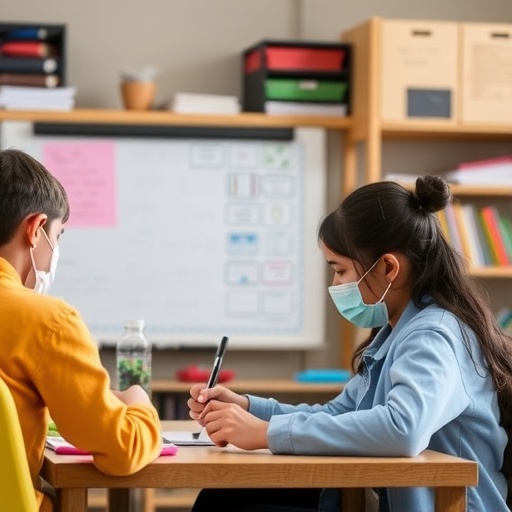The extended impact of the COVID-19 pandemic has wrought unprecedented changes across various educational landscapes, especially within the STEM (science, technology, engineering, and mathematics) disciplines. A recent systematic literature review led by notable scholar L. Beruin explores these transformative effects by meticulously examining learning privileges experienced by STEM students across diverse educational phases: pre-pandemic, pandemic, and post-pandemic. The outcomes of this comprehensive analysis afford educators, policymakers, and stakeholders deep insights into the evolving dynamics of STEM education.
At the heart of this research lies a critical focus on identifying the differential learning privileges that have emerged within these educational periods. Pre-pandemic or traditional academic settings provided students with established infrastructures, including physical classrooms, face-to-face interactions, and robust peer-to-peer networking opportunities. These environments were heavily laden with resources—access to advanced experimental labs, research materials, and mentorship from established professionals—setting a precedent of educational equity, at least in more robust institutions.
However, the advent of the pandemic forced educational institutions worldwide into unprecedented closures and a rapid pivot to online learning platforms. This evolution ushered in a host of complications and disparities that greatly affected equity in learning environments. As Beruin’s review reveals, many STEM students lacked necessary tools such as high-speed internet, suitable learning spaces, and adequate technological devices at home. This disparity created a digital divide that disproportionately affected marginalized communities, which often grappled with limited access to these essential resources. The sudden shift not only altered instructional methodologies but also exacerbated existing inequalities in STEM education.
As educational institutions adapted to these challenges, innovations surfaced. Many educators embraced online tools and platforms, creating flexible and diverse instructional methods that included synchronous and asynchronous learning environments. The pandemic prompted the development of engaging digital content and collaborative online tools that could bridge geographical barriers. Nonetheless, while some students thrived in these innovative frameworks, others struggled significantly, illustrating the dichotomy in learning privileges that the pandemic precipitated.
Transitioning to the post-pandemic phase, Beruin’s analysis indicates a new paradigm of education emerging that leverages hybrid learning models. These models integrate both physical and virtual learning environments, capitalizing on the inherent benefits of each. However, sustaining this hybrid approach presents its own set of challenges, especially concerning student engagement and motivation. The review underscores the importance of ongoing research into how these models can be optimized to support diverse learning needs and preferences effectively.
The literature further illuminates the psychological dimensions of these educational shifts, noting that while some STEM students demonstrated resilience and adaptability, others faced significant mental health challenges as a result of the abrupt transition and ongoing uncertainties. The implications for educational psychology are profound, necessitating immediate attention to students’ emotional well-being alongside their academic performance. Schools and universities are called to foster supportive environments that prioritize mental health, aiming to mitigate the adverse effects of extended isolation and increased stress.
Beruin’s review doesn’t shy away from addressing the perspectives of educators as well. The role of teachers transformed dramatically during the pandemic. Many adapted their instructional strategies, embracing technology to engage their students through novel means. This experience has potentially redefined professional development needs within the teaching workforce, indicating the necessity for continuous training focused on digital literacy and hybrid teaching methodologies.
Moreover, the discussion surrounding equity in STEM education gains traction through this review. The findings reinforce the call for deliberate and targeted interventions to encompass all students, especially those from historically underrepresented backgrounds. Increasing access to resources, mentorship opportunities, and financial support systems are core to restoring equity in STEM disciplines. Institutions are urged to reassess their outreach programs and recruitment strategies to ensure inclusive and supportive environments that empower every student to succeed.
Across the various learning periods examined, it is important to consider the role of policy in shaping the educational landscape. As the world gradually stabilizes in the aftermath of the pandemic, policymakers are at a crucial juncture where evidence-based strategies should guide the decision-making processes. Funding for digital resources, enhancement of infrastructure, and investments in teacher training are pivotal components that must be prioritized to create sustainable progress in STEM education.
In conclusion, Beruin’s systematic literature review elucidates the complex nature of learning privileges experienced by STEM students across three pivotal periods. The insights derived from this comprehensive analysis not only highlight the disparities that have emerged but also reveal opportunities for growth and innovation within the educational landscape. As STEM fields continue to evolve, understanding and addressing these learning privileges will be essential for ensuring equitable access to educational resources and opportunities for every student.
This exploration of STEM education during such transformative times serves as a reminder of the resilience of the academic community. As challenges persist, so too does the opportunity for collaboration, innovation, and reform. The future of STEM education hinges on our ability to critically reflect, adapt, and respond to the evolving needs of our students, ensuring that each learner can thrive in an increasingly complex world.
Subject of Research: Learning privileges experienced by STEM students across pre-pandemic, pandemic, and post-pandemic learning periods.
Article Title: A systematic literature review of learning privileges experienced by STEM students across pre-pandemic, pandemic, and post-pandemic learning periods.
Article References:
Beruin, L. A systematic literature review of learning privileges experienced by STEM students across pre-pandemic, pandemic, and post-pandemic learning periods.
Discov Educ 4, 459 (2025). https://doi.org/10.1007/s44217-025-00902-y
Image Credits: AI Generated
DOI: 10.1007/s44217-025-00902-y
Keywords: STEM education, digital divide, learning privileges, hybrid learning, educational equity.




